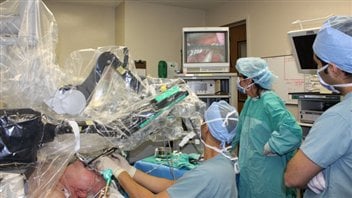Canadian researchers will investigate whether using a tiny robot and camera for neck and throat cancer surgery will be better than the current treatment. Surgeon Dr. Anthony Nichols (left) and radiation oncologist Dr. David Palma have received a $223,000 grant from the Canadian Cancer Society to conduct the study.
The incidence of these cancers is increasing dramatically because of an epidemic of HPV (human papilloma virus) infection, a sexually-transmitted disease.
The current treatment involving radiation with or without chemotherapy is effective but can sometimes causes nasty side effects that can affect the patient’s quality of life. They may have problems with speaking, swallowing, tasting and hearing and some patients even end up dependent on feeding tubes.

By using a tiny robot and camera, surgeons can remove tumours and patients may avoid potential side-effects of radiation and chemotherapy. This technique is especially useful for cancers in the tonsils and the back of the throat, areas which are difficult to access, says Dr. Anthony Nichols, a head and neck surgeon and professor at Western University.
“With this new surgical robot it makes it easier to see because there’s this double-barrelled camera that’s in the back of the throat that’s angled so you can see around that corner. There’s also two small robotic arms that can work around that corner and they even scale down your movements so if my hand moves 5 centimetres the robot instrument moves just one centimetre. And it also takes out a tremor so you can do this very fine work around the corner to do a proper cancer operation that was otherwise quite difficult without the robot.”
Nichols has already used this technique on a patient on an experimental basis with good results. But that doesn’t mean it will be the best one for everyone. “Medicine in general, there’s been many things that have been implemented that we think are better and then many years later it’s not clearly better,” says Nichols. “And so this trial is going to formally compare radiation versus surgery for the treatment of these cancers.”
So he and other scientists will conduct a 3-year study to find out. Some 300 patients with early stage cancer will be divided into two groups. One group will get the traditional radiation with or without chemotherapy. The other will get the robotic surgery. One year after treatment they will be assessed for side effects and quality of life.
In addition Nichols says there should be sophisticated study of the genetics and molecular changes in the tumors. This could eventually help doctors tailor personalized treatments that might combine robotic surgery with radiation and/or chemo in different ways depending on the makeup of the tumor.







For reasons beyond our control, and for an undetermined period of time, our comment section is now closed. However, our social networks remain open to your contributions.